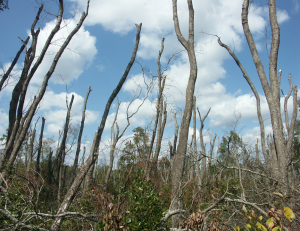
Non-native trees in the Boiling Pots Section of Wailuku River State Park on Hawai‘i Island, near Hilo, with African tulip tree (Spathodea campanulata) in the right foreground and numerous Mollucan albizia (Falcataria moluccana) in the background.
Nonnative tree species have received less scientific attention than nonnative species in general, but when a forest is colonized by a nonnative tree species, the ecological effects can be significant as a change in tree species composition can alter the structural and functional attributes of forest ecosystems.
A recent report authored by USDA Forest Service scientists and partners (including Kevin Potter of North Carolina State University) documents an increase in nonnative tree species in forests in the conterminous U.S. and on Pacific and Caribbean islands.
In the report, “The contribution of nonnative tree species to the structure and composition of forests in the conterminous United States in comparison with tropical islands in the Pacific and Caribbean,” the authors assessed the abundance, geographic distribution, contribution to forest structure (including carbon), and temporal trends of nonnative tree species using publicly available data from the U.S. Department of Agriculture Forest Service, Forest Inventory and Analysis (FIA) program.
The authors found that the forest land area with nonnative tree species in the conterminous United States (CONUS) is 18.8 million acres (7.6 million ha) and is expanding at about 500,000 acres (202 343 ha) per year. The contribution of nonnative tree species in the CONUS to the structural component of forests (basal area and tree density) increased slightly.
The contribution of nonnative tree species to the carbon storage of CONUS forests was 92.6 gigapounds (42 Tg) of C or about 0.05 percent of the amount stored in those forests. Nonnative tree species also sequestered 1.3 gigapounds (0.6 Tg) of C annually or about 0.5 percent of the carbon sink of CONUS forests. The type and intensity of human activity is generally associated with the presence of nonnative tree species. A similar relationship was detected in Caribbean and Pacific islands. Additionally, a greater concentration of human activities in islands makes the nonnative tree species more common there than in the CONUS.
The report can aid managers and policymakers in assessing the impacts of nonnative trees on forest composition.
Read the full text of the report.
March 16, 2022




